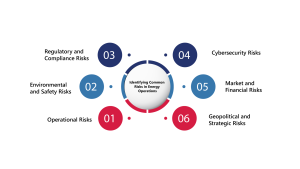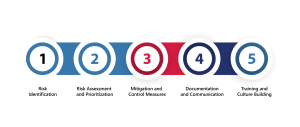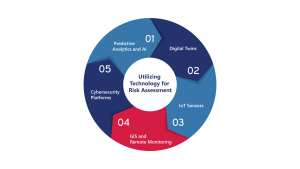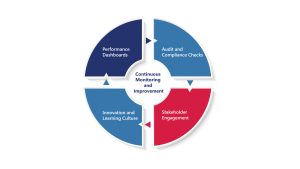Risk Management in the Energy Sector: Strategies for Resilience and Operational Excellence
The energy sector—encompassing oil & gas, renewables, utilities, and nuclear—is vital to global economic stability and development. Yet, it also faces some of the most complex and high-stakes risks of any industry. From geopolitical disruptions and regulatory shifts to equipment failure and environmental threats, risk management in the energy sector must be proactive, resilient, and dynamic.
In this guide, we delve into the essential strategies for managing risk in energy operations. We’ll explore how to identify vulnerabilities, plan for disruptions, leverage technology, and create a culture of continuous monitoring and improvement—strengthened by operational risk audits, digital risk enablement for energy companies, and compliance training for energy operations.
Identifying Common Risks in Energy Operations
Before effective mitigation can begin, energy organizations must first understand the diverse and evolving risks they face. These risks can be broadly categorized into several key areas:
● Operational Risks
These involve day-to-day activities such as equipment failures, safety incidents, process inefficiencies, and supply chain management consulting delays. In oil and gas, for example, a malfunctioning pipeline can lead to production halts, revenue loss, and safety hazards.
● Environmental and Safety Risks
Energy operations often take place in sensitive or hazardous environments. Risks include oil spills, gas leaks, radiation exposure, and waste mismanagement. The environmental impact of such incidents can damage reputations and lead to regulatory fines or shutdowns.
● Regulatory and Compliance Risks
The energy sector is tightly regulated, and non-compliance with environmental, health, and safety standards can result in legal action, fines, and loss of operating licenses. Staying ahead of constantly changing policies—particularly in carbon regulation—is essential.
● Cybersecurity Risks
As energy infrastructure becomes increasingly digital and connected, cyber threats such as ransomware, hacking, and data breaches pose serious risks. Attacks on SCADA (Supervisory Control and Data Acquisition) systems can disrupt production and grid stability.
● Market and Financial Risks
Commodity price volatility, foreign exchange fluctuations, and economic downturns can impact project viability, capital expenditure, and return on investment.
● Geopolitical and Strategic Risks
Energy companies often operate across borders and in politically unstable regions. Political unrest, nationalization of resources, or sanctions can threaten operations and assets.
By identifying these risk categories early, organizations can design a holistic strategy that anticipates and prepares for the full spectrum of potential disruptions.
Developing a Risk Management Plan for Energy Sector Operations
A robust risk management plan is the foundation for navigating uncertainty in the energy sector. The process involves a systematic, organization-wide approach that includes the following stages:
1. Risk Identification
This step involves cross-functional input—from operations, safety, finance, legal, IT, and external stakeholders. Tools such as risk registers, historical incident databases, audits, and SWOT analyses help uncover hidden vulnerabilities.
2. Risk Assessment and Prioritization
Risks should be assessed based on likelihood and potential impact. Techniques like Heat Maps and Failure Mode and Effects Analysis (FMEA) allow organizations to rank risks and focus on those with the highest severity.
3. Mitigation and Control Measures
Depending on the nature of the risk, companies can choose from four main responses:
- Avoidance: Eliminate activities with excessive risk.
- Reduction: Implement controls to reduce the probability or impact.
- Transfer: Use insurance or outsourcing to shift risk.
- Acceptance: Acknowledge and monitor lower-level risks.
Common control measures include predictive maintenance schedules, compliance training for energy operations, redundant systems, and supply chain diversification.
4. Documentation and Communication
All risk plans, procedures, and roles should be clearly documented and accessible. Communication is key—every stakeholder should know their responsibilities and how to escalate concerns.
5. Training and Culture Building
Risk management is not a one-time activity. Cultivating a risk-aware culture ensures that employees proactively report issues, follow protocols, and contribute to safety and compliance goals. This is where crisis response planning in energy plays a central role.
Utilizing Technology for Risk Assessment
Digital transformation has opened powerful new avenues for identifying, assessing, and responding to risks in real time. Technology is no longer a support function—it is a core enabler of risk intelligence and operational excellence consulting firms.
● Predictive Analytics and AI
Advanced algorithms can analyze operational data to forecast potential failures or unsafe conditions. For instance, vibration analysis and thermal imaging can detect stress on turbines and pipelines before they break down.
● Digital Twins
A digital twin is a virtual replica of physical assets or processes. In energy infrastructure, digital twins allow operators to simulate scenarios—such as overloads, weather events, or supply interruptions—without endangering real assets.
● IoT Sensors
Connected sensors placed throughout plants, rigs, and grids can detect anomalies like pressure changes, corrosion, or unauthorized access. These devices provide real-time visibility into asset health and safety compliance, crucial to business operations consulting firm success.
● GIS and Remote Monitoring
Geospatial data helps track environmental risks such as flood zones, seismic activity, and pipeline encroachments. Drones and satellite imaging enable remote inspection of hard-to-reach facilities.
● Cybersecurity Platforms
Monitor for threats and vulnerabilities across the digital ecosystem—a must for modern operations consulting firms.
Integrating these tools within a digital risk enablement for energy companies strategy improves agility and resilience.
Crisis Response Planning and Business Continuity for Energy Companies
Despite best efforts, crises can and do occur. What separates resilient companies from the rest is their ability to respond quickly, minimize impact, and recover efficiently.
● Scenario Planning
Companies should develop response plans for a wide range of scenarios—from cyberattacks and environmental disasters to power outages and civil unrest. Each plan should include specific actions, decision trees, and chain-of-command structures.
● Emergency Response Teams
Dedicated crisis management teams must be trained and ready to execute under pressure. These teams should regularly conduct tabletop exercises and live drills to test readiness.
● Communication Protocols
Clear communication is critical during crises. Establish internal alert systems, external media response guidelines, and coordination channels with government agencies and emergency responders.
● Business Continuity Planning
BCP ensures that essential services continue during and after a disruption. This includes data backups, alternative energy sources, remote work capabilities, and supplier contingency plans.
● Post-Incident Review
After each event, conduct a thorough review to identify lessons learned, process breakdowns, and areas for improvement. Updating procedures based on real-world feedback is key to evolving your risk posture.
Strong crisis preparedness reduces disruption, aligns with cost reduction consultants’ methodologies, and builds trust.
Continuous Monitoring and Improvement
Risk management is not a one-time fix—it must be continuously refined to stay effective. The energy landscape evolves quickly, and so must your strategies.
● Performance Dashboards
Real-time dashboards track key risk indicators (KRIs) such as safety violations, unplanned outages, equipment reliability, and compliance status. Visualizing this data helps leadership spot trends and act before issues escalate.
● Audit and Compliance Checks
Regular audits ensure that safety measures, training programs, and control systems are followed consistently. These checks are vital for maintaining certifications, insurance coverage, and stakeholder confidence.
● Stakeholder Engagement
Engage employees, contractors, regulators, and community members in risk discussions. Their insights and concerns can reveal blind spots and foster collaboration.
● Innovation and Learning Culture
Encourage experimentation with new technologies and methods. Stay current with global best practices and regulatory updates. Organizations that embrace continuous learning are more resilient and agile in the face of change.
With regular updates and leadership backing, risk management becomes a competitive advantage—and a pillar of strategy consulting firms.
CCO Consulting: Enabling Digital Risk Enablement and Operational Resilience
At CCO Consulting, we specialize in helping energy companies identify, mitigate, and manage risk with confidence. Our expertise includes:
- Operational Risk Audits: We assess your current operations and flag vulnerabilities across assets, people, and processes.
- Digital Risk Enablement: From IoT deployments to AI modeling, we design and implement technology that improves decision-making and reduces incident rates.
- Compliance and Safety Training: Our programs keep your teams aligned with OSHA, EPA, ISO, and industry-specific regulations.
- Crisis Simulation and Recovery Planning: We prepare your teams to respond to disruptions with clear roles, plans, and recovery strategies.
Whether you’re a utility navigating grid modernization or a renewables firm scaling fast, we partner with you to build long-term resilience.
Conclusion: Why Risk Management Is Vital for the Energy Sector’s Future
The energy sector’s complexity makes risk management in the energy sector more than just a task—it’s a strategic imperative. With proper planning, modern tools, and expert guidance from operational excellence consulting firms, energy companies can thrive even in uncertainty.
Partner with CCO Consulting, your trusted business operations consulting firm, to lead with confidence, protect your assets, and unlock long-term growth.





